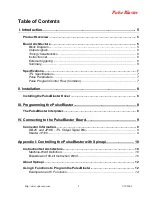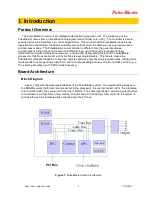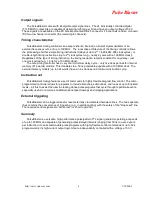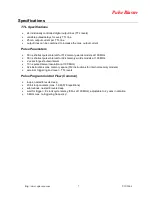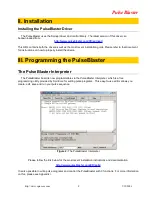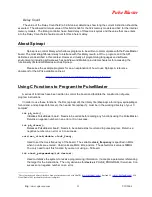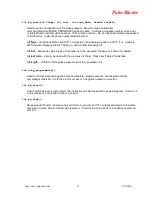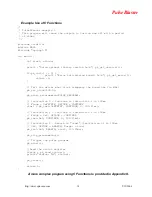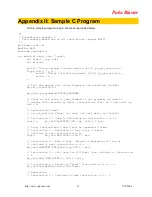
PulseBlaster
Output signals
The PulseBlaster comes with 24 digital output signal lines. The 24 individually controlled digital
(TTL/CMOS) output bits are capable of delivering
±
25 mA per bit and have an output voltage of 3.3V.
These signals are available on the PC bracket-mounted DB-25 connector (16 channels) and an on-board
IDC two-row header connector (the remaining 8 channels).
Timing characteristics
PulseBlaster’s timing controller can accept either an internal (on-board) crystal oscillator or an
external frequency source of up to 100 MHz. The innovative architecture of the timing controller allows
the processing of either simple timing instructions (delays of up to 2
32
= 4,294,967,296 clock cycles), or
double-length timing instructions (up to 2
52
clock cycles long – nearly 2 years with a 100 MHz clock!).
Regardless of the type of timing instruction, the timing resolution remains constant for any delay – just
one clock period (e.g., 10 ns for a 100 MHz clock).
The core-timing controller has a very short minimum delay cycle – only five clock periods for internal
memory (512 words) models. This translates to a 50 ns pulse/delay/update with a 100 MHz clock. The
external memory models (up to 32k words) have a nine clock-period minimum instruction cycle.
Instruction set
PulseBlaster’s design features a set of commands for highly flexible program flow control. The micro-
programmed controller allows for programs to include branches, subroutines, and loops at up to 8 nested
levels – all this to assist the user in creating dense pulse programs that cycle through repetitious events,
especially useful in numerous multidimensional spectroscopy and imaging applications.
External triggering
PulseBlaster can be triggered and/or reset externally via dedicated hardware lines. The two separate
lines combine the convenience of triggering (e.g., in cardiac gating) with the safety of the "stop/reset" line.
The required control signals are “active low” (or short to ground).
Summary
PulseBlaster is a versatile, high-performance pulse/pattern TTL signal generator operating at speeds
of up to 100 MHz and capable of generating pulses/delays/intervals ranging from 50 ns to over 2 years
per instruction. It can accommodate pulse programs with highly flexible control commands of up to 32k
program words. Its high-current output logic bits are independently controlled with a voltage of 3.3 V.
http://www.spincore.com
5/19/2006
6



